Cast iron pulley manufacturers specialize in producing pulleys – fundamental mechanical components essential for force transmission. A pulley is a simple machine comprising a grooved wheel, typically mounted on an axle, designed to guide and support a rope, cable, or chain. Its primary functions are to change the direction of an applied force and to multiply force, thereby enabling users to lift or move heavy objects with significantly reduced effort.
The operation of a pulley system relies on the principle of mechanical advantage. This advantage is achieved by distributing the load’s weight across multiple segments of the supporting rope or cable. Essentially, the force required to lift an object decreases proportionally as the number of rope segments engaged by the pulleys increases. This principle makes pulleys indispensable in a vast array of applications:
Industrial Machinery: Found in elevators for vertical transport, cranes for heavy lifting, and conveyor belts for material handling.
Everyday Items: Used in common household systems like window blinds for raising/lowering and clotheslines for supporting laundry.
Engineered Systems: Integral to complex rigging, sailboat controls, well mechanisms, and exercise equipment.
Cast iron, favored by pulley manufacturers for its exceptional durability, wear resistance, and cost-effectiveness, is a common material choice, particularly for demanding industrial environments where strength and longevity are paramount.
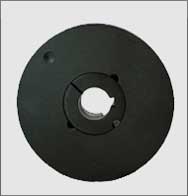
Design of Conical Belt Pulley Width Plate
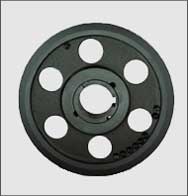
Design of flower holes for tapered belt pulleys
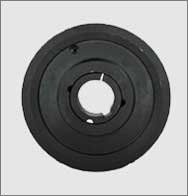
Small plane design of cone sleeve pulley
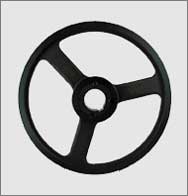
Design of Ribs for Conical Sheave Pulley
The Detail size for some cast iron pulley model
|
Model |
Number of slots |
Nodal circle(mm) |
OD(mm) |
Aperture range(mm) |
|
SPB125-05 |
5 |
125 |
132 |
18-50 |
|
SPB132-05 |
5 |
132 |
139 |
20-60 |
|
SPB140-05 |
5 |
140 |
147 |
|
|
SPB150-05 |
5 |
150 |
157 |
|
|
SPB160-05 |
5 |
160 |
167 |
|
|
SPB170-05 |
5 |
170 |
177 |
25-75 |
|
SPB180-05 |
5 |
180 |
187 |
|
|
SPB190-05 |
5 |
190 |
197 |
|
|
SPB200-05 |
5 |
200 |
207 |
|
|
SPB212-05 |
5 |
212 |
219 |
|
|
SPB224-05 |
5 |
224 |
231 |
|
|
SPB236-05 |
5 |
236 |
243 |
35-90 |
|
SPB250-05 |
5 |
250 |
257 |
|
|
SPB280-05 |
5 |
280 |
287 |
|
|
SPB300-05 |
5 |
300 |
307 |
|
|
SPB315-05 |
5 |
315 |
322 |
|
|
SPB335-05 |
5 |
335 |
342 |
|
|
SPB355-05 |
5 |
355 |
362 |
|
|
SPB400-05 |
5 |
400 |
407 |
|
|
SPB450-05 |
5 |
450 |
457 |
|
|
SPB500-05 |
5 |
500 |
507 |
|
|
SPB560-05 |
5 |
560 |
567 |
40-100 |
|
SPB630-05 |
5 |
630 |
637 |
|
|
SPB710-05 |
5 |
710 |
717 |
|
|
SPB800-05 |
5 |
800 |
807 |
|
|
SPB900-05 |
5 |
900 |
907 |
55-110 |
|
SPB1000-05 |
5 |
1000 |
1007 |
|
|
SPB1250-05 |
5 |
1250 |
1257 |
Cast Iron pulley calculation formula
The motor speed is 1400 rpm, and the pulley diameter is 30 centimeters,The speed is 650 revolutions per minute. May I know the diameter of the motor pulley?
How much is it?
Cast iron pulley drawing design
The letter “P” on the pulley drawing represents the pitch circle; Generation “O” refers to outer diameter; “F” represents the wheel thickness; “L” represents the hole length; “N” represents Small outer diameter.
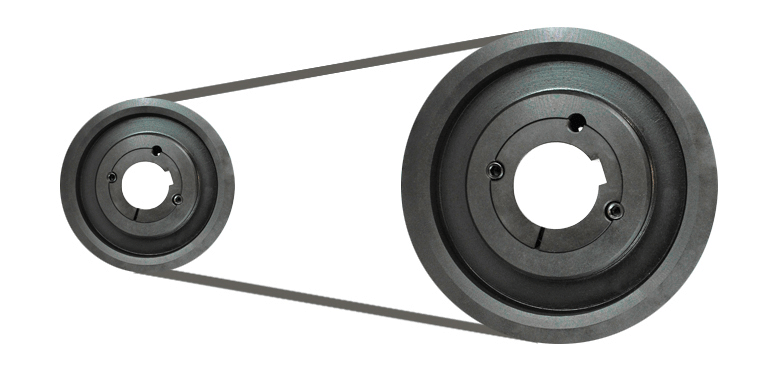
Features of our cast iron pulley
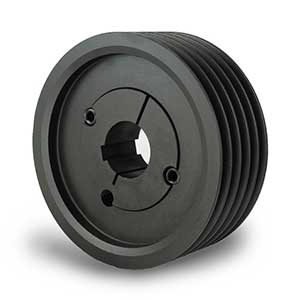
1. Cast iron pulley surface phosphating blackening
Surface phosphating and blackening treatment, beautiful and elegant, improving the overall quality of the machine. Increase rust resistance and extend service life
2. Strictly follow the international DIN2211 standard for production and achieve international integration of accessories
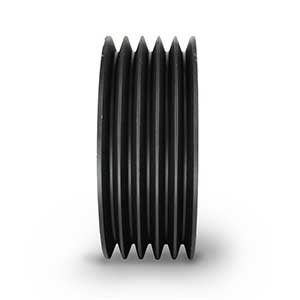
3. Smooth transmission
-
- Before leaving the factory, it must undergo a dynamic balance test with minimal vibration.
- Can achieve the purpose of extending the service life of the entire mechanical system.
4. Simple structure and convenient disassembly and assembly.
5. Six advantages of cast iron pulleys:
- 1. Easy to process: Gray cast iron has good processing performance, especially in the processing of belt grooves. If steel parts are used, it is very difficult to process, while using gray cast iron is quite easy.
- 2. High precision and less prone to deformation: This can be said to be the main reason why gray cast iron is popular. Gray cast iron has very little deformation, and after groove cutting, it will hardly deform, ensuring that the behavior tolerance meets the requirements, thereby ensuring transmission accuracy.
- 3. Good shock absorption performance: Gray cast iron has excellent shock absorption, which can prevent vibration during operation.
- 4. Good casting performance: Gray cast iron has good casting performance and can be cast into rib plates and web plates through molds. If cast steel is used, its casting performance is much worse, which is also one of the reasons for choosing gray iron.
- 5. Wear resistance and long life cycle: Gray cast iron also has better wear resistance than steel parts. The belt pulley rotates continuously to avoid wear, and the material selection is the main reason.
- 6. Small thermal deformation and durability: Gray cast iron has very small thermal deformation, while steel parts will be very large. To avoid deformation, gray cast iron is usually used.
Cast iron pulley design detail




- Humanized chamfering design
- Keyway design
- Surface phosphating and blackening treatment
- Screw hole design
Cast iron pulley application examples
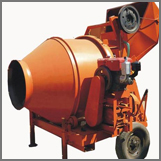
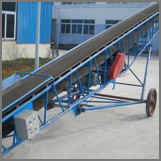
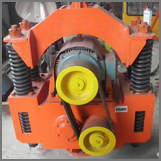
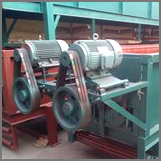

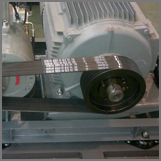
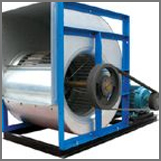
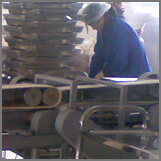
Cast iron pulley manufacturer
As a leading manufacturer in the industry, we pride ourselves on the exceptional quality of our Cast iron pulleys. We have years of experience crafting and machining these pulleys according to the highest standards in the marketplace.
You can rest assured that all of our products are made with the utmost care and precision to ensure long lasting use, durability, and optimum performance. Whether you’re looking for a new replacement pulley for your industrial machines or you need a custom-made pulley for a specific application, we have the expertise and resources to deliver the perfect solution for you. Contact us today to learn more about our Cast iron pulley manufacturing capabilities and how we can help you with all your pulley needs.
Three major misconceptions in the maintenance of tapered belt pulleys
Many companies work all day to ensure production, resulting in equipment always running non-stop 24 hours a day. So the maintenance of equipment parts is particularly important. What are the misconceptions in the maintenance of cone sleeve pulleys, as incorrect maintenance methods can lead to damage to machinery and mechanical accidents?
Three major maintenance misconceptions for cone sleeve pulleys:
- The tighter the bolt, the better. There are many fasteners connected with bolts and nuts in cars, and they should be ensured to have sufficient pre tightening force, but they should not be tightened too tightly. If tightened too tightly, the bolts and connectors will undergo permanent deformation, and the preload will actually decrease, even causing slipping or breakage.
- The tighter the transmission belt, the better. If the transmission belt is adjusted too tightly, it is easy to stretch and deform, while the tapered pulley and bearings are prone to bending and damage.
- The more oil there is, the better. If there is too much oil, the crankshaft and connecting rods of the engine will experience severe agitation during operation, which not only increases the internal power loss of the engine, but also leads to oil burning and discharging faults due to the increased amount of oil splashed onto the cylinder wall.
Can cast iron pulleys with sand inclusion be used?
Do you think the surface of cast iron pulleys used in industry is black and smooth? You may not have had actual contact with it. Most European standard pulleys have undergone phosphating blackening and dynamic balancing treatment, but ordinary cast iron pulleys often experience sand inclusion during production and processing which most China sand casting foundry may meet.. What is “sanding”?
It is estimated that only those who frequently deal with cast iron pulleys will be more familiar with it. When sand inclusions appear on the cast iron pulley, it indicates a defect, which is an “expansion defect”. It also has two other forms: “rat tail” and “groove”. This kind of defect is irreversible, but after being processed by the manufacturer, it can still be used on production equipment with lower balance requirements. What causes the phenomenon of “sand inclusion”? Let’s analyze together.
The principle of sand inclusion in cast iron pulleys:
Its formation is due to the continuous erosion of high-temperature molten iron between the sand molds during casting, coupled with the heating effect of baking, which causes the water in the sand mold to migrate and expand in volume, resulting in the surface layer lifting and cracking.
To avoid the occurrence o f sand inclusion in two aspects:
f sand inclusion in two aspects:
1. Make qualified sand molds. Strictly control the material quality of sand molds; Select the appropriate casting mold based on the casting; Increase the exhaust holes of the sand mold.
2. It is best to use a relatively low temperature for rapid casting during casting, choose a suitable casting position, and facilitate the stable filling of iron horizontally and the discharge of gas.
Sipx casting reminder: Although cast iron pulleys with “sand inclusion” phenomenon can also be used in industrial production, we still try to reduce this phenomenon as much as possible to make customers feel at ease when using them. Of course, there will be no such concerns when purchasing Sipx cast iron pulleys.
Reasons and prevention methods for sand sticking and surface roughness on belt pulleys
1、 Sticky sand and rough surface: Sticky sand is a surface defect in castings, manifested as sand particles adhering to the surface of the pulley that are difficult to remove; If the belt pulley has an uneven and unsmooth surface after removing sand particles, it is called rough surface.
2、 Cause of occurrence:
- The sand particles are too coarse and the compactness of the sand mold is not enough;
- The high moisture content in the molding sand makes it difficult to compact;
- The pouring speed is too fast, the pressure is too high, and the temperature is too high;
3. The template drying temperature is too high, causing the surface molding sand to dry up; Or if the drying temperature of the template is too low, the molding sand will adhere to the template.
4、 Prevention method:
- When the permeability is sufficient, use finer raw sand and appropriately increase the compactness of the molding sand;
- Strictly control the moisture content of the sand to ensure a stable and effective coal powder content in the molding sand;
- Improve the pouring system, improve pouring operations, and reduce pouring temperature;
- Control the baking temperature of the template, generally equal to or slightly higher than the temperature of the molding sand.
Reasons and prevention methods for sand sticking and surface roughness on belt pulleys

FAQ

A cast iron pulley is a mechanical device used to transmit power from one rotating shaft to another. It is typically made from cast iron material, which is known for its high-strength and durability.
Cast iron pulleys are available in various shapes and sizes to suit different applications. Some common types include V-belt pulleys, timing belt pulleys, flat belt pulleys, and multi-groove pulleys.
We meet the ISO8062(GB/T6414) CT4-CT8 of Nominal dimension (mm) Linear dimension tolerance
Cast iron pulleys are highly resistant to wear and tear, making them ideal for heavy-duty applications. They are also very strong and rigid, which helps to reduce vibration and avoid belt slippage. Cast iron pulleys also have a longer lifespan than other materials used
The size of the cast iron pulley you need will depend on the application for which it will be used. Factors such as the RPM of the driving and driven shafts, the power being transmitted, and the diameter of the pulley will affect the size of the pulley required. It is important to consult a specialist to ensure you select the correct pulley for your specific application.
Pulleys made from cast iron material are very robust and require minimal maintenance. Regular inspection of the pulley for any signs of wear or damage, such as cracks or chips, is re

At SipxMach, our goal is to help our customers lower production costs and increase production rates and quality. Interested to see what SipxMach can do for you and your team? Contact us to schedule a tour of our state-of-the-art facility
- Contact: Rubio
- Email: [email protected]
- Microsoft Teams: Rubioli8677 (Sales manager)
- Office Add: No.551, Baosheng Avenue, Huixing Street, Yubei District, Chongqing, China
- Foundry Add: No. 4 Jindi Avenue, Dongcheng Street, Tongliang District, Chongqing
